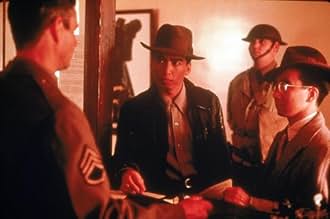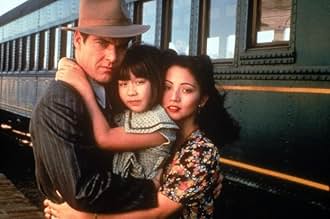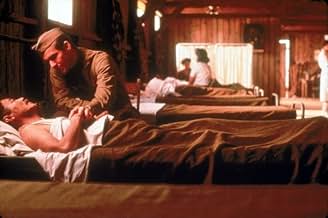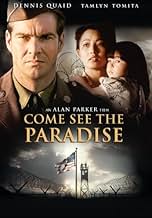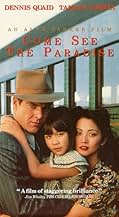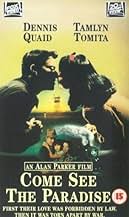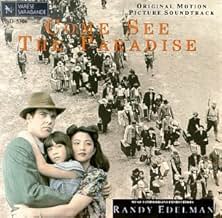Agrega una trama en tu idiomaThe passionate romance between an Irish-American man and a Japanese-American woman is threatened when the Pearl Harbor attacks happen and the woman is forced into a prison camp because of he... Leer todoThe passionate romance between an Irish-American man and a Japanese-American woman is threatened when the Pearl Harbor attacks happen and the woman is forced into a prison camp because of her ethnicity.The passionate romance between an Irish-American man and a Japanese-American woman is threatened when the Pearl Harbor attacks happen and the woman is forced into a prison camp because of her ethnicity.
- Dirección
- Guionista
- Elenco
- Premios
- 3 nominaciones en total
- Dirección
- Guionista
- Todo el elenco y el equipo
- Producción, taquilla y más en IMDbPro
Opiniones destacadas
The movie moves deliberately. It takes its time to show the cultural differences and give the romance some space. It's a bit slow but it works as an old fashion romantic film. It doesn't really heighten the drama more than a simple melodrama level. The running time is over two hours long and probably would work better with less. This starts as a fine love story about Jack and Lily but that drama fades into the background in the second half. The camp part of the movie becomes more about telling different aspects of life through the family members.
Like many films, "Come See The Paradise" is about the strength of love. The fact that it uses this period as a backdrop sets it apart from the rest. The chemistry between Quaid and Tomita is amazing. Just watch them together when they meet for the first time and they kiss. It's simply stunning. Quaid has rarely been this good, and Tomita is obviously relishing having a lead role. In most of her films she's listed as "(somebody's) wife". Films like this and "The Joy Luck Club" prove that she is one of the most talented and under-used actresses.
Some have complained that this film uses an "American" character to tell the story of a "Japanese" family. As if any non-Japanese audience members would not be able to understand, or relate to, the Japanese family. The Quaid character is called "un-American" because of his labor rights stance. The family is called "un-American" simply because they are of Japanese descent. Even though the children were born in the United States. So what exactly does it mean to be "un-American"?
Side note: this movie has not been released on DVD. I anxiously await that day.
¿Sabías que…?
- TriviaThe movie ranks at the No. #1 spot on the top 10 list of most Oscar-bait movies ever made according to research by UCLA sociologists Gabriel Rossman and Oliver Schilke. According to website 'Wikipedia', this movie is "the most deliberate example of Oscar bait in their study of 3,000 films released since 1985. The identification is based on various elements calculated to be likely to draw Oscar nominations, including the previous nominations of [Alan] Parker, the film's setting in Hollywood (including Quaid's projectionist character), and its depiction of a tragic historical event against the background of war and racism. It was only released in a few cities during the last week of that year to make it eligible for the awards. However, it was not nominated for any Oscars and failed at the box office".
- ErroresDuring the destroying Japanese businesses scene, the "I am an American" sign is printed as if from a professional printers, however, it's entirely possible that people had signs professionally printed.
- Citas
[first lines]
Older Mini McGann: Why are we so early?
Lily Yuriko Kawamura: It's good to be early.
Older Mini McGann: Do you ever worry that you won't recognize him, Mama?
Lily Yuriko Kawamura: You recognize me, don't you?
Older Mini McGann: Well, he might have grown a beard or a moustache or something. And I was so little. I only think I remember him. Do you think he'll remember me?
Lily Yuriko Kawamura: Well, he has all your photographs and all the letters you wrote him, and he has all your school reports
Older Mini McGann: You sent him my school reports?
Lily Yuriko Kawamura: Of course I did. I wanted to let him know how well you were doing. Come on, now. I got some tea and rice cakes here. We'll have a nice talk while we're walking, okay? Let's go.
Older Mini McGann: How far do we have to walk?
Lily Yuriko Kawamura: Not far.
Older Mini McGann: If we have so much time, then why are you walking so fast? I shouldn't have worn these new shoes. I think I have a blister. Mama!
[speaks in Japanese]
Lily Yuriko Kawamura: [replies in Japanese] Try not to think about it. You want to look pretty, don't you?
Older Mini McGann: Can we talk about Papa?
Lily Yuriko Kawamura: Okay.
- Créditos curiososThe 20th Century Fox logo does not have the fanfare on it.
- Bandas sonorasKawamura Family Theme
Written by Jake Parker and Alan Parker
Selecciones populares
- How long is Come See the Paradise?Con tecnología de Alexa
Detalles
Taquilla
- Presupuesto
- USD 17,500,000 (estimado)
- Total en EE. UU. y Canadá
- USD 947,306
- Fin de semana de estreno en EE. UU. y Canadá
- USD 65,532
- 25 dic 1990
- Total a nivel mundial
- USD 947,306
- Tiempo de ejecución2 horas 18 minutos
- Color
- Mezcla de sonido
- Relación de aspecto
- 1.85 : 1
Contribuir a esta página



